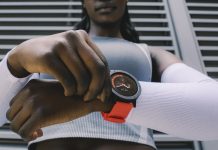
Smartwatches have been around in their current guise (grouped loosely) for four or so years now, and many of us will remember the original Pebble somewhat fondly. However, development in the smartwatch space hasn’t gone exponentially upwards since then; if anything, it’s stagnated a little, with many believing that tech journos are conspiring to kill off the category altogether.
The killer features of smartwatches have been notifications on the wrist and fitness tracking, and really everything else (and we do mean everything) has been superfluous, and mostly poorly received. Consider the crap features that various OEMs have built into smartwatches:
- Integrated camera
- IR remote
- Dick Tracy-style built in phones
- Music players
- Keyboards
There’s more, but these are the ones that come to mind, and in each case, we find ourselves wondering… why? While there has been demand for more and more features in mobiles, and there’s been success for those who’ve integrated them, the same has not been the case for smartwatches, where often it’s the case that more is too much. Do we need smartwatches with integrated, awful keyboards, terrible cameras, and the ability to make phone calls? I’d suggest we don’t, and the market seems to agree.
How do we know? Flagging sales suggest that the rapid iteration of mobiles doesn’t translate well to smartwatches, and major brands are significantly slowing their efforts in wearables, with some (like Motorola) pulling out almost entirely, while brands that are keeping it simple continue to find success.
Fitbit has figured this out, and they’re doing very well out of it; they’ve made a range of fitness trackers that are both accurate, functional and some of them even look good: the signature Fitbit look has become like the white Apple headphones, where you want to be seen wearing something distinctive to show that you have the best. Fitbit has made the jump in wearables from brand name to generic; regardless of the fitness tracker you’re wearing, it’s inevitable people will ask if you’ve got a Fitbit.
On the other hand, those who try to jam in too much are finding less and less appeal. Samsung and LG have crammed everything but the kitchen sink into their more recent smartwatches, including LTE, speakerphones and more, leading us to wonder “what else?” It doesn’t help that Android Wear’s inclusion of the kitchen sink is being led by Google itself, with their push for speakers (we can see a place for speakers) and LTE (less so).
While LG’s smartwatches haven’t been big sellers in Australia, Samsung’s Gear S2/S3 range have done alright, but even in my review, I noted that they tried to do way too much, and that 95% of the features no one will ever use.
The Real Test
The real test of a smartwatch is whether you can usefully do something in just a few seconds. Glancing at a notification is super handy, but interacting with it quickly detracts from the user experience; Android Wear’s quick reply functionality is great, allowing you to reply to messages with emoji, a dictated response, or a dinky on-screen keyboard, but even then, most people will not be using this — they’ll triage the message, decide whether to whip their phone out and interact with it that way.
Anything more than this — initiating a message, reading the news, playing a game — is too much, and most often, users will simply pull their phone out instead. How do I know this? Everyone I’ve seen with a smartwatch does it — they’ll glance at their watch, not even touch it, and pull out their phone instead, presumably to read a message or email on a larger, easier to use screen, and handle it as necessary. I almost never reply to messages from my watch, unless it’s a simple “OK”, or “OMW” type message.
I’d suggest this is the kind of line that most people draw, and it’s why Fitbit have done so well — they track your fitness, sync it to a class-leading service (and it’s open to 3rd parties, too), and show you notifications so you can decide whether to get your phone out.
What we would really like
So, in 2017, what we want from smartwatches is this:
- Get notifications right, 100% right. Make them beautiful, easy to read, functional, and informative.
- Get fitness tracking right: if your claim to fame is fitness tracking, make your HR monitors accurate, and get everything else pretty spot on.
- Leave out the crap: we don’t want speakerphones, we don’t want keyboards, we don’t want app stores crowded with useless tools.
We want a watch that tells the time, shows us our schedule at a glance, shows us notifications, tracks our steps and our heart rates, preferably is waterproof, and looks good. It doesn’t need to be a dress watch, but it needs to look reasonable with a collar and sleeves and with a polo or a t-shirt on the weekend. We want a battery that lasts a weekend without a charger without sacrificing functionality, wireless charging so there’s no fiddly cables to fumble with in the dark, and something comfortable to wear all day (and night) if needed.
If we had one extra wish, it’d be inclusion of a tap-and-pay solution, and Android Pay seems to be the most widely supported at the moment. That would absolutely seal the deal for me; not even having to grab my phone out (much less my wallet) to pay for things. Integrate my Opal card too, and I’d be in seventh heaven.
Do we care if it doesn’t run Android Wear or Samsung’s Tizen? Not at all; in fact, it might be better if it doesn’t.
Are we likely to see a more minimalist smartwatch that gets these features right? Probably not. Samsung’s Gear platform is headed in the everything-including-the-kitchen-sink direction, and while Android Wear has always been a bit more minimal than that, Android Wear 2.0 certainly doesn’t look too promising, eschewing minimalism for MOAR FEATURES.
What do you want in a smartwatch in 2017?




